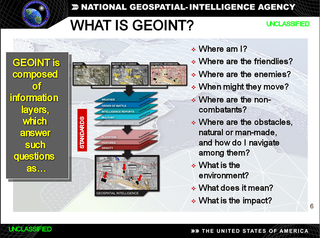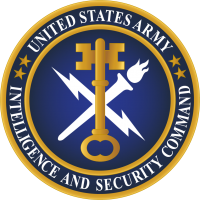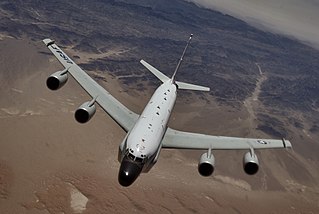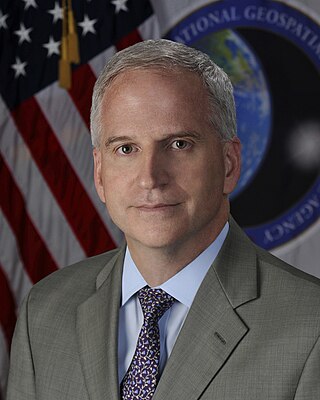Related Research Articles

The National Geospatial-Intelligence Agency (NGA) is a combat support agency within the United States Department of Defense whose primary mission is collecting, analyzing, and distributing geospatial intelligence (GEOINT) in support of national security. Initially known as the National Imagery and Mapping Agency (NIMA) from 1996 to 2003, it is a member of the United States Intelligence Community.

The National Reconnaissance Office (NRO) is a member of the United States Intelligence Community and an agency of the United States Department of Defense which designs, builds, launches, and operates the reconnaissance satellites of the U.S. federal government, and provides satellite intelligence to several government agencies, particularly signals intelligence (SIGINT) to the NSA, imagery intelligence (IMINT) to the NGA, and measurement and signature intelligence (MASINT) to the DIA.
Measurement and signature intelligence (MASINT) is a technical branch of intelligence gathering, which serves to detect, track, identify or describe the distinctive characteristics (signatures) of fixed or dynamic target sources. This often includes radar intelligence, acoustic intelligence, nuclear intelligence, and chemical and biological intelligence. MASINT is defined as scientific and technical intelligence derived from the analysis of data obtained from sensing instruments for the purpose of identifying any distinctive features associated with the source, emitter or sender, to facilitate the latter's measurement and identification.
An intelligence officer is a person employed by an organization to collect, compile or analyze information which is of use to that organization. The word of officer is a working title, not a rank, used in the same way a "police officer" can also be a sergeant, or in the military, in which non-commissioned personnel may serve as intelligence officers.

The United States Naval Criminal Investigative Service (NCIS) is the primary law enforcement agency of the U.S. Department of the Navy. Its primary function is to investigate criminal activities involving the Navy and Marine Corps, though its broad mandate includes national security, counterintelligence, counterterrorism, cyberwarfare, and the protection of U.S. naval assets worldwide. NCIS is the successor organization to the former Naval Investigative Service (NIS), which was established by the Office of Naval Intelligence after the Second World War.

In the United States, geospatial intelligence (GEOINT) is intelligence about the human activity on earth derived from the exploitation and analysis of imagery, signals, or signatures with geospatial information. GEOINT describes, assesses, and visually depicts physical features and geographically referenced activities on the Earth. GEOINT, as defined in US Code, consists of imagery, imagery intelligence (IMINT) and geospatial information.

Marine Corps Intelligence is an element of the United States Intelligence Community. The Director of Intelligence supervises the Intelligence Department of HQMC and is responsible for policy, plans, programming, budgets, and staff supervision of Intelligence and supporting activities within the U.S. Marine Corps as well as supervising the Marine Corps Intelligence Activity (MCIA). The Department supports the Commandant of the Marine Corps (CMC) in his role as a member of the Joint Chiefs of Staff (JCS), represents the service in Joint and Intelligence Community matters, and exercises supervision over the MCIA.

The under secretary of defense for intelligence and security or USD(I&S) is a high-ranking civilian position in the Office of the Secretary of Defense (OSD) within the U.S. Department of Defense (DoD) that acts as the principal civilian advisor and deputy to the secretary of defense (SecDef) and deputy secretary of defense (DepSecDef) on matters relating to military intelligence and security. The under secretary is appointed as a civilian by the president and confirmed by the Senate to serve at the pleasure of the president.

The Office of Intelligence and Counterintelligence (OICI), also abbreviated IN, DOE-IN, DOE/IN, I&CI, or OIC, was established in 2006 by the merger of pre-existing Energy Department intelligence and security organizations. It is an office of the United States Department of Energy (DOE) responsible for all intelligence and counterintelligence activities throughout the DOE complex; due to this central role, OICI is designated DOE's Headquarters Intelligence. As a component of the United States Intelligence Community in addition to the Department of Energy, OICI reports to both the Director of National Intelligence and Secretary of Energy.

The United States Army Intelligence and Security Command (INSCOM) is a direct reporting unit that conducts intelligence, security, and information operations for United States Army commanders, partners in the Intelligence Community, and national decision-makers. INSCOM is headquartered at Fort Belvoir, Virginia.

Signals intelligence operational platforms are employed by nations to collect signals intelligence, which is intelligence-gathering by interception of signals, whether between people or between machines, or mixtures of the two. As sensitive information is often encrypted, signals intelligence often involves the use of cryptanalysis. However, traffic analysis—the study of who is signalling whom and in what quantity—can often produce valuable information, even when the messages themselves cannot be decrypted.
Intelligence collection management is the process of managing and organizing the collection of intelligence from various sources. The collection department of an intelligence organization may attempt basic validation of what it collects, but is not supposed to analyze its significance. There is debate in U.S. intelligence community on the difference between validation and analysis, where the National Security Agency may try to interpret information when such interpretation is the job of another agency.
Intelligence cycle management refers to the overall activity of guiding the intelligence cycle, which is a set of processes used to provide decision-useful information (intelligence) to leaders. The cycle consists of several processes, including planning and direction, collection, processing and exploitation, analysis and production, and dissemination and integration. The related field of counterintelligence is tasked with impeding the intelligence efforts of others. Intelligence organizations are not infallible but, when properly managed and tasked, can be among the most valuable tools of management and government.
National intelligence programs, and, by extension, the overall defenses of nations, are vulnerable to attack. It is the role of intelligence cycle security to protect the process embodied in the intelligence cycle, and that which it defends. A number of disciplines go into protecting the intelligence cycle. One of the challenges is there are a wide range of potential threats, so threat assessment, if complete, is a complex task. Governments try to protect three things:
The federal government of the United States empowers a wide range of federal law enforcement agencies to maintain law and public order related to matters affecting the country as a whole.

Robert Cardillo is a Distinguished Fellow at Georgetown University’s Center for Security and Emerging Technology. Prior to this appointment, he was the sixth Director of the National Geospatial-Intelligence Agency and was sworn in October 3, 2014. He was previously selected by Director of National Intelligence James Clapper to serve as the first Deputy Director of National Intelligence for Intelligence Integration in September 2010. Clapper said in a statement that the position would "elevate information sharing and collaboration" between those who collect intelligence and those who analyze it. Cardillo previously served as deputy director of the Defense Intelligence Agency (DIA). Prior to that, he served as the deputy director for Analysis, DIA, and Director, Analysis and Production, National Geospatial-Intelligence Agency (NGA).

Michael H. Decker was the Assistant to the Secretary of Defense for Intelligence Oversight. from September 2009 to February 2014. Before that he was Assistant Director of Intelligence, Marine Corps Intelligence, United States Marine Corps. He served as Director of Intelligence during Operation Iraqi Freedom II from January 2004 to June 2005.
References
- ↑ "All-source intelligence". USLegal.com. Retrieved September 1, 2019.
- ↑ U.S. Department of Defense (February 15, 2013). Joint Publication 1-02, Department of Defense Dictionary of Military and Associated Terms (PDF). Archived from the original (PDF) on February 9, 2017. Retrieved September 1, 2019.
- 1 2 Fingar, Thomas (2012). A Guide to All-source Analysis (PDF). Vol. 19. Journal of Intelligence Studies. Retrieved September 1, 2019.
- ↑ See individual articles for detailed references about all-source missions
- ↑ CIA. "CIA Directorate of Analysis". Archived from the original on May 27, 2010. Retrieved September 1, 2019.
- ↑ DIA. "DIA Analysis and Counterintelligence" . Retrieved September 1, 2019.
- ↑ ONI. "Farragut Technical Analysis Center" . Retrieved September 1, 2019.
- ↑ Providing Invaluable Intelligence – A Brief History of the National Air and Space Intelligence Center (NASIC_history.pdf) (Report).
- ↑ "A Brief History of Headquarters Marine Corps Organization" (PDF). United States Marine Corps . 1970. Retrieved 1 December 2016.
 This article incorporates text from this source, which is in the public domain .
This article incorporates text from this source, which is in the public domain .
- Boris Giannetto (2020). All-Source Intelligence: Reshaping an old Tool for Future Challenges. Security Affairs.
- Lowenthal, Mark M. (2009). Intelligence: From Secrets to Policy. Washington, DC: CQ Press. pp. 38, 125, 139.
- Russell, Richard L. Loch K. Johnson (ed.). Achieving AllSource Fusion in the Intelligence Community. Handbook of Intelligence (New York: Routledge, 2009). pp. 189–198.